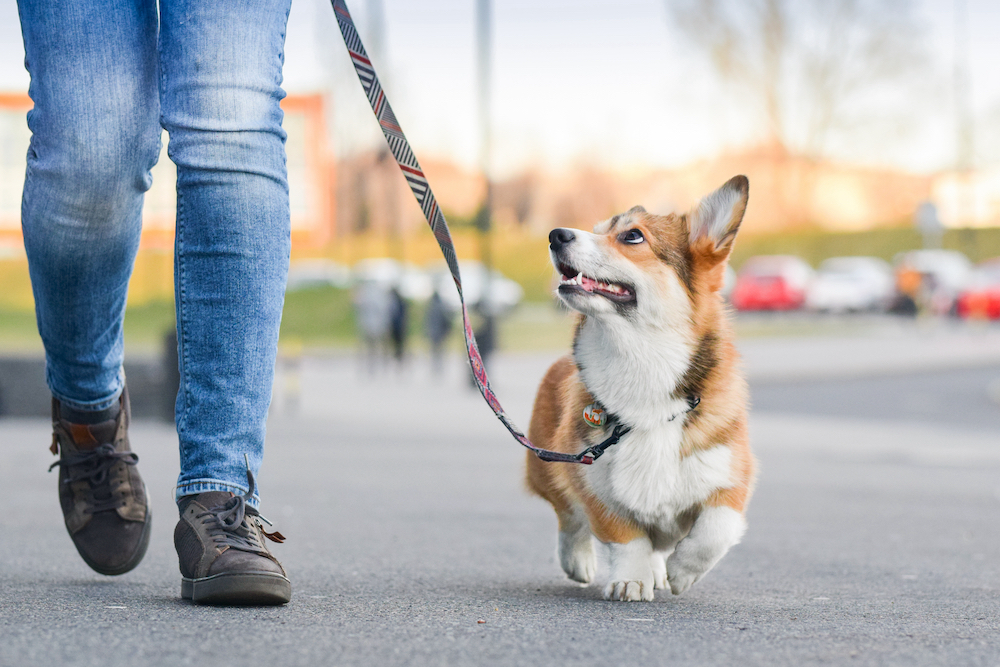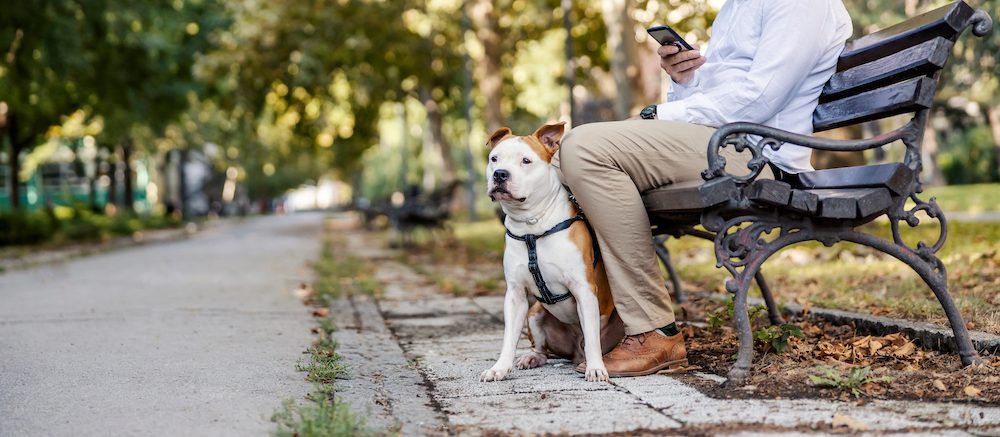Recently, CNN ran an article about the dangers of multitasking while walking your dog. Their warnings are warranted. Walks are great, but dogs may miss out on the activity’s full benefits—and even risk harm—if their humans are not fully engaged. It’s well worth taking the time to enjoy your dog’s company and the outdoors.
Considering the rising awareness of the term “phubbing”—snubbing someone by looking at your phone instead—it feels like a good time to go over reasons to make your dog’s walk about them and resist the temptation to multitask. The phone will be waiting for you later, we promise… but it’s unlikely to greet you with a wagging tail or a lick on your face.
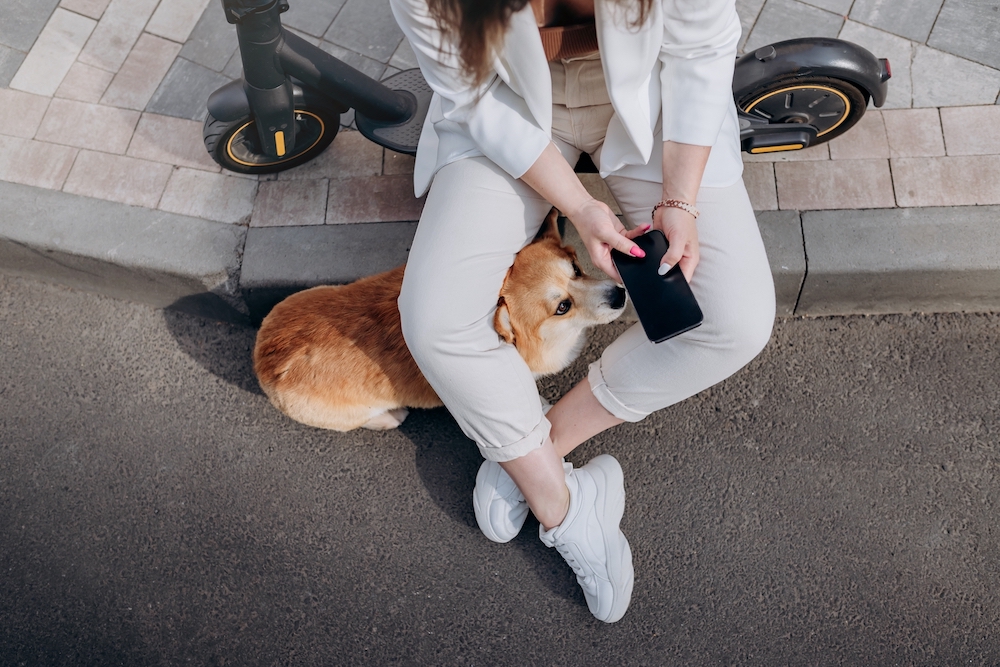
Paying attention helps you protect your dog
Even if a walk seems routine to you, it’s unlikely that you have the power to single-handedly dog-proof the outdoors. Dogs have famously poor judgment about which foods they can eat, and, at times, what even is food. Just because an item is small and a dog could eat it quickly doesn’t mean that it will be harmless. Something as tiny as a raisin could cause your dog serious harm and necessitate a visit to the emergency vet if they scarf it down while you’re checking your fantasy team.
Forbidden food and foreign objects aren’t the only hazards you might encounter on the sidewalk or street. In the summer, pavement may become hot enough to hurt your dogs’ paws—feel it with your own hand first. In the winter, you might come across road salts or other materials that could irritate dogs’ paws or make them sick.
Then there are the potential issues presented by other dogs and humans. If your dog is reactive, they could experience stress or even get into a fight if they unexpectedly get too close to another pup and you haven’t prepared. And some overenthusiastic people have been known to approach dogs in disagreeable ways.
In her book Wag: The Science of Making Your Dog Happy, Dr. Zazie Todd writes that “Walks with a reactive dog require stealth and planning: it means having your eyes and ears open for other dogs at all times, and being alert and ready to move behind a car or tree or change direction to keep the other dog out of sight.”
Humans walking fearful dogs have a lot to do. As Dr. Todd explains, “It’s important to keep fearful dogs safe, which means keeping distance between them and the other dog.” But paying attention also provides you with an opportunity to help your dog get over that fear. “You can teach them to like other dogs after all,” she continues, “by making something nice happen, like feeding them pieces of steak, when another dog is in sight.”
None of this is to say that you should be hyper-vigilant to the point where your dog can’t have the freedom to enjoy their walk. Dr. Marc Bekoff, professor emeritus of ecology and evolutionary biology at the University of Colorado, Boulder, has written about how “helicopter humans” can inadvertently make life harder for their dogs. In collecting data on patterns of humans’ scolding and praising of dogs, Dr. Bekoff “discovered that dogs were reprimanded almost five times more than they were praised.” One simple remedy he suggests is praising your dog for no apparent reason, as long as they’re not doing anything you find objectionable. “Giving praise and being nice and showing affection and love,” he writes, “are okay even when a dog is just walking around or sniffing and isn’t doing anything in particular.”
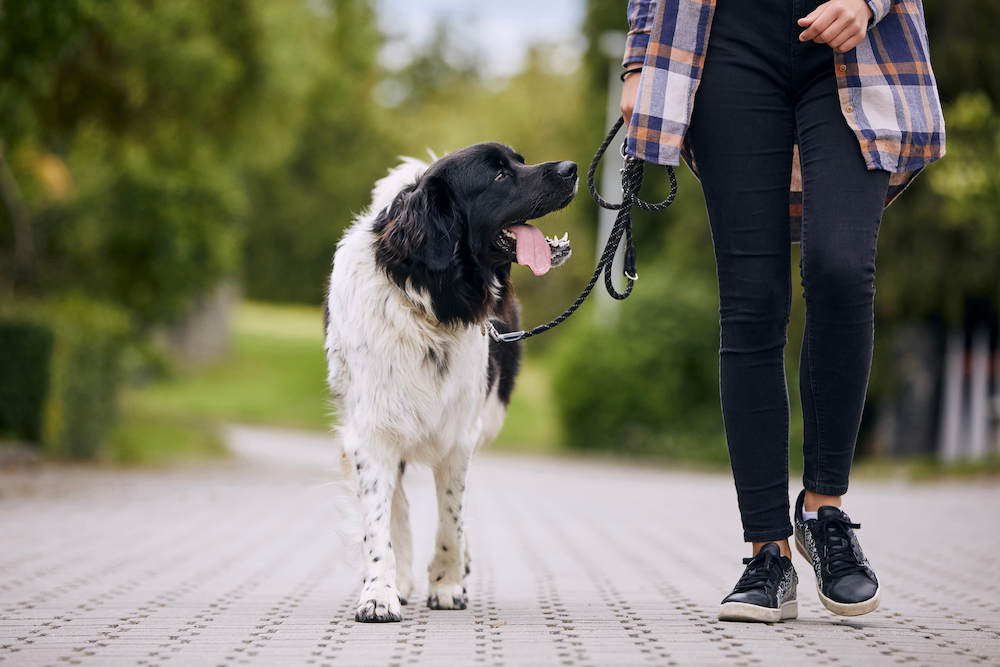
It makes for better citizenship
Dogs tend to relieve themselves during walks, and it’s up to you to dispose of their poop properly—and prevent them from peeing where their urine could hurt plant life. It’s hard to do that if you’re spending the walk planning your next Words With Friends move instead of watching and engaging with your dog.
In addition to the possibility of errant dog waste, there’s the chance that your dog will approach a human or animal who doesn’t want their attention. While we personally find it hard to fathom that there’s anyone in the world who isn’t always excited to see a dog, those people are nevertheless entitled to their personal space. Do them and your dog a favor and stay plugged in during your walk.
It’s a training opportunity
A dog and a human walking together in sync, the dog happily checking in with their person, bopping along and wagging their tail, is a beautiful sight. But it’s not something that happens on its own.
In her book The Year of the Puppy, Dr. Alexandra Horowitz writes that “despite the social appearance of dogs as (more or less) cooperatively walking alongside their people in public… dogs don’t naturally come to these behaviors.” She continues, detailing the challenges dogs face in arriving at good on-leash walking habits: “Walking with us is awkward: we are not at the dog’s pace. Dogs are sprinters, not long-distance walkers. Moreover, they don’t want to go in a straight line, keeping an even gait. They zigzag, stop and sniff, run off to chase unseen moving creatures in the grass. They turn around, go sideways, stop entirely. They wait for other dogs, they pull for other dogs. They smell a spot on the ground intently for minutes.”
Acknowledging dogs’ natural inclinations and preferences will make it easier to get them to stick alongside you during fitness walks and when you’re on a schedule—though you should also give your dog scent-centered walks during which they can take their time and smell to their noses’ content, as sniffing is an important way that they experience the world.
Both in terms of training your dog to walk the way you want and accommodating their need to exercise their strongest sense, focused attention is paramount. Inattentive walking can lead to mixed signals for your dog—you don’t want to accidentally pull them while they’re trying to go to the bathroom, or yank them away from a fun sniffing spot.
Michael Bogese, who co-authored a recent paper on gaze in cats and dogs and has been studying dogs since 2015 (he took a two-year break to study children, but then “wanted to go back to dogs”) says: “with dogs, we found that vocalizations—like owner talking—were correlated with how often dogs kind of checked in and looked at their owners.” This engagement can help you in training your dog and help your dog feel better during a walk. “Naturally,” says Bogese, “being engaged on a dog walk, you’re probably talking more than if you’re scrolling on Instagram or playing Pokemon Go.” Simply paying attention can go a long way toward solidifying your bond.
It also gives you a chance to praise and reward your dog when they do things you like, and to help with counterconditioning of the sort Dr. Todd describes in the context of fear and reactivity. You can also practice commands like “sit,” “leave it,” and “drop it,” all with the advantage of a dog who knows your eyes are on them.
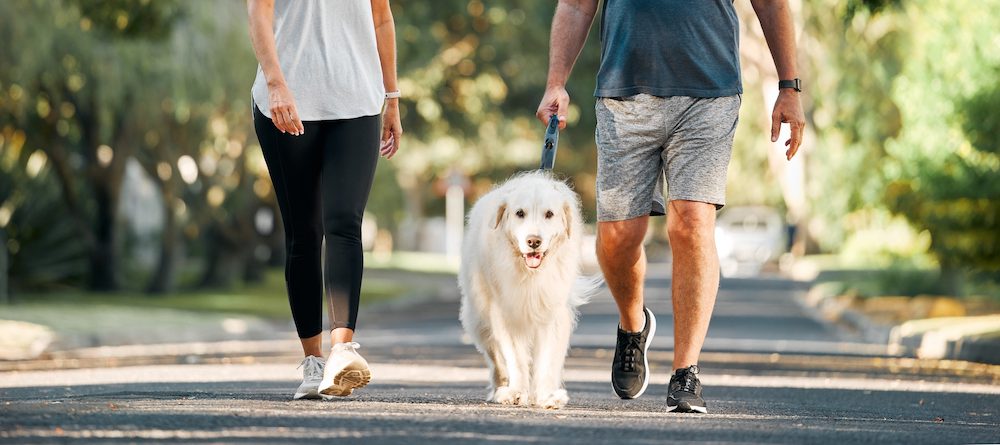
It helps you understand your dog better
You might assume that because dogs have a reputation for liking walks in general, your dog must be having a blast during every walk. But every dog is different, and so is every situation; if you’re not watching your dog during their walk, you might miss signals that they’re stressed—or, on a more positive note, evidence that there’s something they really love.
Even though your dog isn’t likely to make an announcement like “I’m having a wonderful time this afternoon” or “I’m really stressed out,” they will communicate with you through their body language. You could spend years refining your understanding of the clues dogs’ eyes, ears, tails, mouths, and posture offer about their state of mind—both general trends and the particular quirks of your own pup. But you won’t be able to note any of that unless you dedicate your mental energy to the walk in front of you.
“Maybe every day you thought [your dog was] just having fun,” says Bogese, “when it turns out that this block really stresses them out and they’re on alert, and their tail wag is [one of] those really tight kind of back-and-forth movements where the tail is fully erect.”
You may also discover that your dog is fond of or fascinated by a particular patch of plants, is excited to meet some friends on the next block, or has a hankering to walk in a certain direction for reasons you can’t understand yet. Learning more about your dog’s personality is one of the fun parts of caring for one.
It’s good for you, too
Paying attention during walks will benefit your dog, but it’s not exactly a sacrifice for you. It will allow you and your dog to safely experience more of what’s good about a walk. They can sniff more, make more friends (if they like to do that), relieve themselves in a more relaxed fashion, and have more happy moments with you overall.
As for you individually, the benefits of mindfulness—including being fully present in everyday activities—can include reduced stress and improved memory. If you can, it might be a nice change of pace to leave your phone at home altogether for some walks—participants in one study showed reduced cognitive performance with their phone nearby, even if they weren’t using it.
“We know that, baseline, making eye contact with our dog makes us feel good on a hormonal level,” says Bogese. “And the really cool thing is that happens for them, too… So while we’re still learning a lot about what attention does and also what a lack of attention does with dogs, it never hurts to be more attentive and give visual feedback—and I think both you and your dog will feel better at the end of the walk.”



